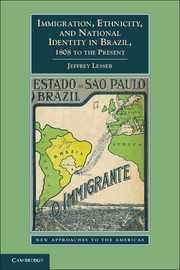Book contents
- Frontmatter
- Contents
- List of Figures, Tables, and Documents
- Acknowledgments
- Chapter 1 Creating Brazilians
- Chapter 2 From Central Europe and Asia
- Chapter 3 Mass Migrations, 1880–1920
- Chapter 4 The Creation of Euro-Brazilian Identities
- Chapter 5 How Arabs Became Jews, 1880–1940
- Chapter 6 Asianizing Brazil
- Epilogue
- Historiographical Essay
- Index
Historiographical Essay
Published online by Cambridge University Press: 05 February 2013
- Frontmatter
- Contents
- List of Figures, Tables, and Documents
- Acknowledgments
- Chapter 1 Creating Brazilians
- Chapter 2 From Central Europe and Asia
- Chapter 3 Mass Migrations, 1880–1920
- Chapter 4 The Creation of Euro-Brazilian Identities
- Chapter 5 How Arabs Became Jews, 1880–1940
- Chapter 6 Asianizing Brazil
- Epilogue
- Historiographical Essay
- Index
Summary
It is surprising how little attention is paid to immigration and immigrants to Latin America in the English-language academic literature. There are a number of explanations. Scholars often treat immigrants as “foreign” and thus outside of the national experience. Many Latin American intellectuals see immigrants and their descendants in the same way. As a result, scholarly work often focuses away from immigration and immigrant ethnicity, often toward questions of race, especially among those of African and indigenous descent.
In Brazil, scholarship on immigration is widespread but frequently conducted outside of the formal academy. Much of the research is done by community historians, especially of groups that have been traditionally oriented toward education. Thus, there are as many books on Jewish and Asian immigrants in Brazil as there are on Portuguese or Italians. In all of the cases, however, the emphasis tends toward community institutions or important individuals.
Within the academy, most research is on elite discourses concerning immigrants. This often leads to the impression that the newcomers were primarily victims. It is only recently that calls for “new ethnic studies” have begun to change research models in Latin America, especially those that would suggest commonalities in the experiences of immigrant groups and their descendants. It is certain that over the next decades we will learn more about the ways in which immigrants and nonimmigrants interacted. We will see studies arguing that the descendants of immigrants should be treated as Brazilians rather than as foreigners. A broader comparative approach to immigration in the Americas is also needed. While we know something about individual nations with large numbers of immigrants (like Brazil, Argentina, Uruguay, the United States, and Canada), we know little about similarities since studies usually emphasize the differences between countries.
- Type
- Chapter
- Information
- Publisher: Cambridge University PressPrint publication year: 2013
- 1
- Cited by

